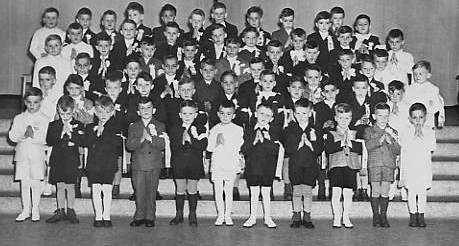
Canadian First Communion Suits: St. Henri (1948)

Figure 1.--We note a First Communion at St. Henri. We think because the children are dressed differently, it probably wasn't a school. Schools often have the childten dress alike. We note both light, dark, and white suits. We also note that the portrait is all boys, this would suggest that St. Henri was more likely a school.
|
We note a First Communion at St. Henri. All we know about St. Henri is that it was located in Montreal, Quebec. I'm not sure if St. Henri was a school or church. We supect it was a church. Of course schools are commonly associated with churches, but churches do not always have schools. We think because the children are dressed differently, it probably wasn't a school. Schools often have the children dress alike. We note both light, dark, and white suits. We also notice what look like sports jackets. Most boys wear short pants suits, but a few boys have long pants suits. We note the boys wearing both long stockings and kneesocks. We also note that the portrait is all boys, this would suggest that St. Henri was more likely a school. Churches did not normally photograph the boys and girls doing First Communion separately.
St. Henri
We note a First Communion at St. Henri. All we know about St. Henri is that it was located in Montreal, Quebec. A Canadian reader tells us, "St-Henri is a district of Montreal, located near Lachine Canal which for more than a century allowed ships to bypass Lachine Rapids in the St-Lawrence River. Today, Eisenhower Seeway on the South Shore is more appropriate for bigger ships to enter the continent as far as Chicago. St-Henri was and still is one of the poorest district of Montreal. It was mainly occupied by French Canadian workers during the growing industrialisation at the end of the 19th Century. At that time, families were very big like it was in the country because people had to obey the priests in avoiding birth control. In that sense, poverty gave rise to more and more poverty. Not so far from South America at the time."
Bonheur d'occasion
A famous novel entitled Bonheur d'occasion by the renowned writer Gabrielle Roy from St-Boniface, Manitoba describes how people suffered from poor conditions of living while leaving rural Quebec for factories along the Lachine Canal in Montreal.
School/Church
I wasn't sure if St. Henri was a school or church. A Canadian reader tells us, "
St, Henri was a District but also a Parish." At first we thought St. Henri was a church. Of course schools are commonly associated with churches, but churches do not always have schools. We think because the children are dressed differently, it probably wasn't a school. Schools often have the children dress alike. We note that the portrait is all boys, this would suggest that St. Henri was more likely a school. Churches did not normally photograph the boys and girls doing First Communion separately. So this must be a school portrait. Our Canadian reader suspects that the poverty of the district made ot difficult to costume the boys alike. Our reader writes, "The picture of boys is caracteristic of the condition of living in that district of Montreal. There was schools for boys and schools for girls, each of them ruled by separate members of clergy. This allboy portrait is a good example of the separatedness of the genders in French Canadian schools. There existed a school for boys named St-Henri."
Clothing
We note both light, dark, and white suits. We also notice what look like sports jackets. Most boys wear short pants suits, but a few boys have long pants suits. We note the boys wearing both long stockings and kneesocks. Note how the children have been poised. All the children in white suits are position at the sides and one boy positioned in the middle. This could not have been an accident. Our Canadian reader writes, "This school First Communion portrait gives a good idea of the family economic position. It was a picture taken before entering the church were girls were on one side and boys on the other. Costumes are an aggregate of badly matched styles at that time. The influence of the clergy is clear in the picture. Boys had to wear short pants and long stockings while attending schools. No uniforms here because the children's parents did not have much money. Many children worn hand-me-downs and many probab;ly wear charity clothing. Short pants cost less to produce and long stockings were given by olders sisters or brothers. The boys in white suits on each side were often chosen by the parish priest and dressed by the parish for the coming ceremony of the "Fête-Dieu". For this ceremony, the entire parish went out the church to walk on the streets."
HBC

Navigate the Boys' Historical Clothing Web Site religious pages:
[Return to the Main Canadian First Communion 1940s page]
[Return to the Main Canadian activities page]
[Return to the Main communion page]
[First Communion]
[Confirmation]
[Ring bearer]
[Victorian wedding]
Navigate the Historic Boys' Clothing Web Site:
[Introduction]
[Activities]
[Biographies]
[Chronologies]
[Countries]
[Style Index]
[Bibliographies]
[Contributions]
[FAQs]
[French glossary]
[Dutch glossary]
[Satellite site]
[Boys' Clothing Home]
Navigate the Historic Boys' Clothing Web chronological pages:
[The 1900s]
[The 1910s]
[The 1920s]
[The 1930s]
[The 1940s]
[The 1950s]
[The 1960s]
[The 1970s]
Navigate the Historic Boys' Clothing Web style pages:
[Short pants suits]
[Blazers]
[Jackets]
[Kilts]
[Sailor suits]
[Sailor hats]
[Ring bearer/page costumes]
[Shortalls]
Created: 12:08 AM 8/13/2005
Last edited: 4:17 AM 8/13/2005



